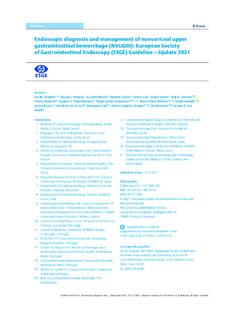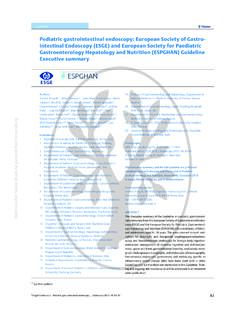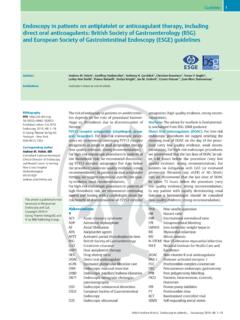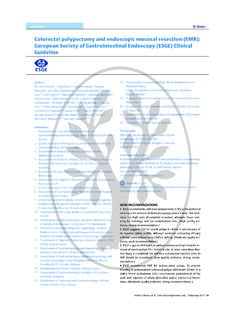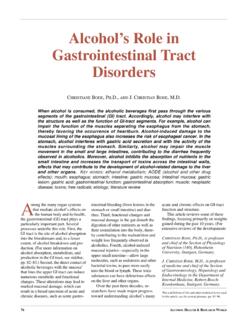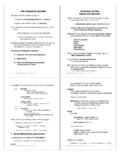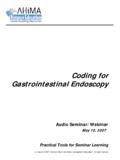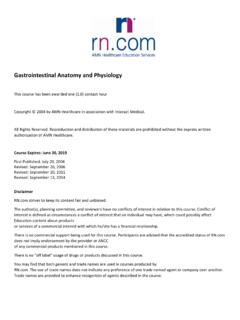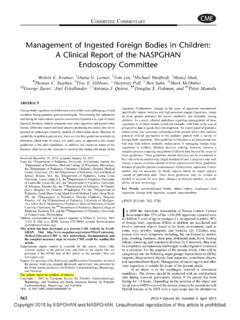Transcription of Removal of foreign bodies in the upper gastrointestinal ...
1 Removal of foreign bodies in the uppergastrointestinal tract in adults: EuropeanSociety of gastrointestinal endoscopy (ESGE)Clinical GuidelineAuthorsMichael Birk1, Peter Bauerfeind2, Pierre H. Deprez3, Michael H fner4, Dirk Hartmann5, Cesare Hassan6, Tomas Hucl7,Gilles Lesur8, Lars Aabakken9, Alexander Meining1 InstitutionsInstitutions are listed at end of online: 2016; 48: 1 8 Georg Thieme Verlag KGStuttgart New YorkISSN 0013-726 XCorresponding authorAlexander Meining, MDDepartment of InternalMedicine I, University of UlmAlbert-Einstein-Allee 2389081 +49-731-44636 Guideline1 Birk Michael et al. Removal of foreign bodies in the upper gastrointestinal tract in adults: (ESGE) Clinical 2016; 48: 1 8 This Guideline is an official statement of the european society of gastrointestinal endoscopy (ESGE). Itaddresses the Removal of foreign bodies in the upper gastrointestinal tract in measures1 ESGE recommends diagnostic evaluation basedon the patient s history and symptoms.
2 ESGE re-commends a physical examination focused onthe patient s general condition and to assess signsof any complications (strong recommendation,low quality evidence).2 ESGE does not recommend radiological evalua-tion for patients with nonbony food bolus impac-tion without complications. We recommend plainradiography to assess the presence, location, size,configuration, and number of ingested foreignbodies if ingestion of radiopaque objects is sus-pected or type of object is unknown (strong re-commendation, low quality evidence).3 ESGE recommends computed tomography (CT)scan in all patients with suspected perforation orother complication that may require surgery(strong recommendation, low quality evidence).4 ESGE does not recommend barium swallow, be-cause of the risk of aspiration and worsening ofthe endoscopic visualization (strong recommen-dation, low quality evidence).5 ESGE recommends clinical observation withoutthe need for endoscopic Removal for managementof asymptomatic patients with ingestion of bluntand small objects (except batteries and magnets).
3 If feasible, outpatient management is appropriate(strong recommendation, low quality evidence).6 ESGE recommends close observation in asymp-tomatic individuals who have concealed packetsof drugs by swallowing ( body packing ). We re-commend against endoscopic retrieval. We re-commend surgical referral in cases of suspectedpacket rupture, failure of packets to progress, orintestinal obstruction (strong recommendation,low quality evidence).Endoscopic measures7 ESGE recommends emergent (preferably within2 hours, but at the latest within 6 hours) thera-peutic esophagogastroduodenoscopy for foreignbodies inducing complete esophageal obstruc-tion, and for sharp-pointed objects or batteries inthe esophagus. We recommend urgent (within 24hours) therapeutic esophagogastroduodenoscopyfor other esophageal foreign bodies without com-plete obstruction (strong recommendation, lowquality evidence).8 ESGE suggests treatment of food bolus impac-tion in the esophagus by gently pushing the bolusinto the stomach.
4 If this procedure is not success-ful, retrieval should be considered (weak recom-mendation, low quality evidence).The effectiveness of medical treatment of esopha-geal food bolus impaction is debated. It is there-fore recommended, that medical treatmentshould not delay endoscopy (strong recommen-dation, low quality evidence).9In cases of food bolus impaction, ESGE recom-mends a diagnostic work-up for potential under-lying disease, including histological evaluation, inaddition to therapeutic endoscopy (strong recom-mendation, low quality evidence).10 ESGE recommends urgent (within 24 hours)therapeutic esophagogastroduodenoscopy forforeign bodies in the stomach such as sharp-poin-ted objects, magnets, batteries and large/long ob-jects. We suggest nonurgent (within 72 hours)therapeutic esophagogastroduodenoscopy formedium-sized blunt foreign bodies in the stom-ach (strong recommendation, low quality evi-dence).11 ESGE recommends the use of a protective de-vice in order to avoid esophagogastric/pharyngealAbbreviations!
5 CTcomputed tomographyESGEE uropean society of gastrointestinal EndoscopyGRADEG rading of Recommendations Assessment,Development and EvaluationNASPGHAN North American society for Pediatric Gastroente-rology, Hepatology and NutritionIntroduction! foreign body ingestion and food bolus impaction are encounter-ed commonly in clinical practice. The majority of foreign body in-gestions occur in the pediatric population. Most ingested foreignbodies (80% 90%) pass spontaneously. However, approximately10% 20% of cases of foreign body ingestion require endoscopicremoval, while less than 1% will need surgery for foreign bodyextraction or to treat complications [1 7]. This Guideline aimsto provide endoscopists with a comprehensive review of diagnos-tic and therapeutic treatment options for swallowed foreign bod-ies in adults. For the management of ingested foreign bodies inchildren we refer to the clinical report of the NASPGHAN Endos-copy Committee [8].
6 Methods!The european society of gastrointestinal endoscopy (ESGE) com-missioned this Guideline and appointed a guideline leader ( )who invited the listed authors to participate in the project devel-opment. The guideline development process included meetingsand online discussions among members of the guideline commit-tee during January 2015 and July 2015. Key questions were pre-pared by the coordinating team ( and ). A systematic lit-erature search in PubMed/MEDLINE and the Cochrane Librarywas conducted using the search terms foreign body AND inges-tion AND gastrointestinal NOT child and foreign bodies ANDendoscopy AND gastrointestinal NOT child to identify publica-tions since 2000 on this topic, to prepare evidence-based state-ments on the key questions. Articles were first selected by title,their relevance was then assessed by reviewing full-text articles,and publications with content that was considered irrelevantwere excluded.
7 All selected articles were graded by the level ofevidence and strength of recommendation according to theGrading of Recommendations Assessment, Development andEvaluation (GRADE) system. Evidence tables were generated foreach key question, summarizing the level of evidence of the avail-able studies. Draft proposals were presented to the entire groupfor general discussion and voting during a plenary meeting heldin July 2015 (Munich, Germany).In August 2015, a draft prepared by and was sent to allgroup members. After agreement on a final version, the manu-script was submitted to the journalEndoscopyfor journal subjected the manuscript to peer review, and themanuscript was amended to take into account the reviewers comments. The final revised manuscript was agreed upon by allthe and statements! foreign body ingestion and food bolus impactionIngestion of true foreign bodies ( nonfood objects) occursmore frequently in children than in adults.
8 In adults, esophagealfood bolus impaction is a much more common problem with anestimated annual incidence of 13/100000 people [9]. True for-eign body ingestion in adults, either intentional or unintentional,appears more often in the elderly population; in patients withpsychiatric disorders developmental delay, or alcohol intoxica-tion; and in prisoners seeking secondary gain [1 7]. A classifica-tion of foreign bodies is listed in "Table1; some examples areshown in " measuresESGE recommends diagnostic evaluation based on the patient s historyand symptoms. ESGE recommends a physical examination focused on thepatient s general condition and to assess signs of any complications(strong recommendation, low quality evidence).For communicative adults, history of ingestion including timing,type of ingested foreign body and onset of symptoms is usuallyreliable. In mentally impaired adults and in cases of intentionalforeign body ingestion for secondary gain ( by prisoners), amedical evaluation can be difficult.
9 Patients with esophageal for-eign bodies , particularly impacted food boluses, are almost al-ways symptomatic and can specify the onset of symptoms and lo-calize discomfort exactly. However, the area of discomfort oftendoes not correlate with the site of impaction [1,2,4,10]. Esopha-geal foreign bodies result in symptoms such as dysphagia, odyno-phagia, or retrosternal pain; sore throat, foreign body sensation,retching, and vomiting are also very common. Respiratory symp-toms include choking, stridor, or dyspnea and can result from as-Table1 Classification of swallowed foreign objectsRound objects: coin, button, toyBatteries, magnetsSharp-pointedobjectsFine objects: needle, toothpick, bone, safety-pin,glass piecesSharp irregular objects: partial denture, razor bladeLong objectsSoft objects: string, cordHard objects: toothbrush, cutlery, screwdriver, pen,pencilFood bolusWith or without bonesOthersPackets of illegal drugsdamage and aspiration during endoscopic extraction of sharp-pointed foreign bodies .
10 Endotracheal intubation should be con-sidered in the case of high risk of aspiration (strong recommen-dation, low quality evidence).12 ESGE suggests the use of suitable extraction devices accord-ing to the type and location of the ingested foreign body (weakrecommendation, low quality evidence).13 After successful and uncomplicated endoscopic Removal ofingested foreign bodies , ESGE suggests that the patient may bedischarged. If foreign bodies are not or cannot be removed, acase-by-case approach depending on the size and type of theforeign body is suggested (weak recommendation, low qualityevidence).Birk Michael et al. Removal of foreign bodies in the upper gastrointestinal tract in adults: (ESGE) Clinical 2016; 48: 1 8 Guideline2piration of saliva or from tracheal compression by the foreignbody. Hypersalivation and inability to swallow any liquids aresuspicious for complete esophageal obstruction [3 7,10 15].When the foreign body has passed the esophagus, the majorityof patients remain asymptomatic but a sensation of foreignbody, with dysphagia, can persist for several hours and thus canmimic a persisting foreign body examination is mandatory to detect ingestion-relatedcomplications such as small-bowel obstruction.
